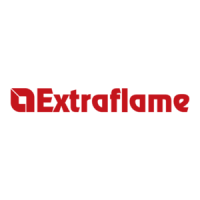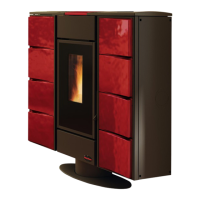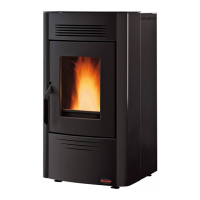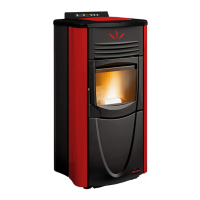Do you have a question about the Extraflame Dorina and is the answer not in the manual?
Guidelines for safe operation and use of the appliance, including child safety and electrical precautions.
Explanation of routine maintenance as defined by decree, focusing on reducing degradation and handling accidental events.
Description of various devices incorporated in the appliance models for safety and functionality.
List of installation standards and regulations the appliance must comply with for heat generators and chimneys.
Requirement to adhere to national, regional, provincial, and town council laws and standards for installation.
Definitions of key terms related to appliance operation, installation, and safety, such as Aeration, Chimney, and Condensation.
Overview of pre-installation checks including site suitability, fumes exhaust system, and air inlets.
Summary of installation activities, covering ventilation, fumes exhaust, connections, insulation, and testing.
Steps concerning complementary documentation and the subsequent inspection and maintenance phases.
Specifications for installation locations, including load-bearing capacity and non-combustible materials.
Requirements for installing inserts, ensuring access to internal parts is prevented.
Essential requirements for the fumes exhaust system, ensuring adequate dispersion and avoiding forbidden materials.
Specific guidelines for appliances using an electric fan for fume expulsion, detailing horizontal sections and bends.
Illustrations showing correct methods for connecting the appliance to the chimney system.
Mandatory requirements for chimneys releasing combustion products, including pressure, section, and direction changes.
Information on ducted systems, specifying compliance with UNI EN 1856-2 for flexible hoses.
Essential criteria for chimney caps, ensuring adequate outlet section and protection from weather.
Determining the minimum height for fumes expulsion relative to roof covering and reflux area.
Product requirements for the fumes exhaust system, including temperature class and fire resistance.
Procedure for verifying appliance operation through an ignition test, including time and adjustments.
Guidelines for applying coverings and finishings after verifying the appliance's proper operation.
Documentation to be provided by the installer, including manuals, conformity declaration, and chimney plaque.
Procedure for documenting work when installation steps are carried out by different parties.
Table outlining the recommended frequency for maintenance operations based on appliance type and usage.
Requirements for issuing and documenting inspection and maintenance operations, including anomalies.
How to control the ducting motor using an external thermostat for temperature regulation.
Recommendations for storing pellets in a dry place to ensure problem-free combustion.
Explanation of the various icons displayed on the control panel, indicating status and functions.
Initial recommendations before igniting the stove and essential safety checks.
How to use the optional remote control for adjusting heating power, temperature, and ignition.
Instructions for replacing batteries in the remote control, noting polarity and disposal.
Steps for initial setup after connecting the power cable, including power board activation.
Procedure for adjusting the mains frequency setting (50/60Hz) if an error message appears.
Instructions for setting the clock, date, and year using the control panel.
Procedure for selecting the preferred language for messages displayed on the control panel.
Detailed steps for igniting the stove, including checks and phases like START-UP and WORK.
How to set room temperature and adjust power levels for optimal heating.
Explanation of the automatic burn pot cleaning cycle that occurs during normal operation.
Instructions for safely switching off the appliance, including cooling phases.
Conditions required for the stove to be re-ignited after it has been switched off.
Guidance on performing clean checks and resolving related alarms.
How to adjust pellet feeding percentage to resolve combustion problems like no fuel or excess fuel.
Explanation of the Stand-By function for immediate stove switch-off when the set temperature is reached.
Instructions on how to activate (ON) or deactivate (OFF) the Stand-By function.
Procedure to reset all user-modifiable values to the factory default settings.
How to enable or disable the chrono timer and its various time slots for daily programming.
Details on programming two time spans per day for switch-on and switch-off times, including days of use.
Instructions for cleaning the generator's surfaces and covering using soft cloths and water.
Procedure for cleaning the ceramic glass when cold, using specific detergents or dry methods.
Steps for emptying and cleaning the pellet tank, ensuring it is unplugged and cold.
How to use scrapers for cleaning, preferably when the stove is cold, with safety recommendations.
Instructions for checking and emptying the ash drawer at least once or twice a week.
Procedure for cleaning the heat exchanger chamber monthly to maintain optimal fume flow.
Technician task: checking and replacing door, ash drawer, and burn pot gaskets for proper sealing.
Technician task: yearly vacuuming and cleaning of the flue pipe and horizontal sections.
Procedure for preparing the equipment for shutdown at the end of the season, including emptying the tank.
Disassembly, cleaning of fumes motor and pipe, and application of new silicone.
Inspection and replacement of gaskets on door, ash drawer, and burn pot, with silicone application.
Total cleaning of the combustion chamber and ignition plug tube.
Complete emptying and cleaning of the pellet tank.
Disassembly and removal of dust and pellet debris from the room air fan.
Inspection and cleaning of the air intake pipe and flow sensor.
Guidelines for safe operation and use of the appliance, including child safety and electrical precautions.
Explanation of routine maintenance as defined by decree, focusing on reducing degradation and handling accidental events.
Description of various devices incorporated in the appliance models for safety and functionality.
List of installation standards and regulations the appliance must comply with for heat generators and chimneys.
Requirement to adhere to national, regional, provincial, and town council laws and standards for installation.
Definitions of key terms related to appliance operation, installation, and safety, such as Aeration, Chimney, and Condensation.
Overview of pre-installation checks including site suitability, fumes exhaust system, and air inlets.
Summary of installation activities, covering ventilation, fumes exhaust, connections, insulation, and testing.
Steps concerning complementary documentation and the subsequent inspection and maintenance phases.
Specifications for installation locations, including load-bearing capacity and non-combustible materials.
Requirements for installing inserts, ensuring access to internal parts is prevented.
Essential requirements for the fumes exhaust system, ensuring adequate dispersion and avoiding forbidden materials.
Specific guidelines for appliances using an electric fan for fume expulsion, detailing horizontal sections and bends.
Illustrations showing correct methods for connecting the appliance to the chimney system.
Mandatory requirements for chimneys releasing combustion products, including pressure, section, and direction changes.
Information on ducted systems, specifying compliance with UNI EN 1856-2 for flexible hoses.
Essential criteria for chimney caps, ensuring adequate outlet section and protection from weather.
Determining the minimum height for fumes expulsion relative to roof covering and reflux area.
Product requirements for the fumes exhaust system, including temperature class and fire resistance.
Procedure for verifying appliance operation through an ignition test, including time and adjustments.
Guidelines for applying coverings and finishings after verifying the appliance's proper operation.
Documentation to be provided by the installer, including manuals, conformity declaration, and chimney plaque.
Procedure for documenting work when installation steps are carried out by different parties.
Table outlining the recommended frequency for maintenance operations based on appliance type and usage.
Requirements for issuing and documenting inspection and maintenance operations, including anomalies.
How to control the ducting motor using an external thermostat for temperature regulation.
Recommendations for storing pellets in a dry place to ensure problem-free combustion.
Explanation of the various icons displayed on the control panel, indicating status and functions.
Initial recommendations before igniting the stove and essential safety checks.
How to use the optional remote control for adjusting heating power, temperature, and ignition.
Instructions for replacing batteries in the remote control, noting polarity and disposal.
Steps for initial setup after connecting the power cable, including power board activation.
Procedure for adjusting the mains frequency setting (50/60Hz) if an error message appears.
Instructions for setting the clock, date, and year using the control panel.
Procedure for selecting the preferred language for messages displayed on the control panel.
Detailed steps for igniting the stove, including checks and phases like START-UP and WORK.
How to set room temperature and adjust power levels for optimal heating.
Explanation of the automatic burn pot cleaning cycle that occurs during normal operation.
Instructions for safely switching off the appliance, including cooling phases.
Conditions required for the stove to be re-ignited after it has been switched off.
Guidance on performing clean checks and resolving related alarms.
How to adjust pellet feeding percentage to resolve combustion problems like no fuel or excess fuel.
Explanation of the Stand-By function for immediate stove switch-off when the set temperature is reached.
Instructions on how to activate (ON) or deactivate (OFF) the Stand-By function.
Procedure to reset all user-modifiable values to the factory default settings.
How to enable or disable the chrono timer and its various time slots for daily programming.
Details on programming two time spans per day for switch-on and switch-off times, including days of use.
Instructions for cleaning the generator's surfaces and covering using soft cloths and water.
Procedure for cleaning the ceramic glass when cold, using specific detergents or dry methods.
Steps for emptying and cleaning the pellet tank, ensuring it is unplugged and cold.
How to use scrapers for cleaning, preferably when the stove is cold, with safety recommendations.
Instructions for checking and emptying the ash drawer at least once or twice a week.
Procedure for cleaning the heat exchanger chamber monthly to maintain optimal fume flow.
Technician task: checking and replacing door, ash drawer, and burn pot gaskets for proper sealing.
Technician task: yearly vacuuming and cleaning of the flue pipe and horizontal sections.
Procedure for preparing the equipment for shutdown at the end of the season, including emptying the tank.
Disassembly, cleaning of fumes motor and pipe, and application of new silicone.
Inspection and replacement of gaskets on door, ash drawer, and burn pot, with silicone application.
Total cleaning of the combustion chamber and ignition plug tube.
Complete emptying and cleaning of the pellet tank.
Disassembly and removal of dust and pellet debris from the room air fan.
Inspection and cleaning of the air intake pipe and flow sensor.
| Type | Pellet stove |
|---|---|
| Pellet consumption | 0.6 - 1.5 kg/h |
| Tank capacity | 15 kg |
| Diameter of smoke outlet | 80 mm |
| Pellet Hopper Capacity | 15 kg |
| Efficiency | 90% |
| Flue Diameter | 80 mm |











